![]()
Your source for hard-to-find Top Octave Synthesizer (TOS) ICs and obsolete and hard-to-find Divider ICs.
Top Octave Synthesizer (TOS) IC's
Order Description Type Figure KS-82 13-Note Top Octave Synthesizer MO82B Figure 4 KS-83 13-Note Top Octave Synthesizer MO83B Figure 5 KS-86 12-Note Top Octave Synthesizer MO86B Figure 6 KS-87 12-Note Top Octave Synthesizer MO87B Figure 7 KS-196 12-Note Top Octave Synthesizer AY-3-214 Figure 8 KS-MDD Dual TOS/MDD Retro for Hammond MDD Generator Boards S2555/S2556 Figure 3 KS-C1 Dual TOS Retro for Conn Organs S2555/S2556 Figure 2 KS-G1 Dual TOS Retro for Gulbransen Organs S2555/S2556 Figure 2 KS-L1 Dual TOS Retrot for Lowrey Organs S2555/S2556 Figure 2 KS-T1 Dual TOS Retro for Thomas Organs S2555/S2556 Figure 2 KS-813-1 7-Note Top Octave Synthesizer S2555 Figure 1 KS-813-2 6-Note Top Octave Synthesizer S2556 Figure 1a
Frequency Dividers IC's
Order Description Type KS-4040 Single Spider Divider IC MFC4040 Figure 9 KS-6020 Dual Independent Spider Divider IC MFC6020 Figure 10 KS-6050 Dual Cascased Spider Divider IC MFC6050 Figure 11 KS-180 7-Stage Divider Retro IC SAJ180 Figure 12 KS-455 6-Stage Divider Retro IC PD455 Figure 13 KS-1007 7-Stage Divider IC AY-1-1007 Figure 14 KS-3216 6-Stage Divider Retro IC LM3216 Figure 15 KS-5823 6-Stage Divider Retro IC MM5823 Figure 16
TOS chips (Top Octave Synthesizer) have been one of the mainstays of the organ industry throughout the organ heydays of the 1970's. The majority of the organs in existence today were produced during the rapid growth decade of the '70's. The TOS chips produce the top twelve musical notes which are then divided by a series of divide-by-two chips or keyer LSI's to provide the multiplr octaves required to generate all the notes on a given organ model. The TOS chips replaced the twelve individual oscillator/divider circuits previously utilized by the organ industry in the 1950's and 1960's.
TOS Divisor System
The TOS chips require only one oscillator frequency, usually 1 MHz to 2 MHz. this high frequency signal supplies the clock frequency which is then divided by the TOS chips into the twelve equally tempered top octave musical notes of the scale. The twelve divisor ratios are multiples of the twelfth root of two which is 1.05946. This means that the equal interval between successive notes of the musical scale are separated by the ratio of 1.05946 to 1. For example, 2 MHz divided by 478 results in a frequency of 4186 Hz which is a C5 note, usually designated as C5 or the first note of octave five, the highest octave on a standard 5 octave, 61 note keyboard. The next note C#5, then would be 4186 Hz x 1.05946 which equals 4434.9 Hz (C#5). This is equal to the 2 MHz clock being divided by 451. This progression continues up to B5 which is a divisor ratio of 253. To produce C6, the highest note of 61 on a 5 octave keyboard, a thirteenth divisor ration of 239 is required. Most of the TOS chips actually have a 13 divisor ratios. If a TOS with only 12 divisor ratios is utilized, the chip produces C#5 through C6. C5 is derived by sending the C6 note (8362 Hz) into a divide-by-two chain within the IC. This divides the 8362 Hz in half which is note C5 (4186 Hz). All lower octaves use a succession of divide-by-two "divider" chips to produce all the necessary octave notes for a given instrument. The most common "divider" chips that were used by organs and synthesizers are shown in Figures 9 through 16, (see the TOS Index above).
Dual 6-Note and 7-Note TOS IC's
The first TOS IC's to be utilized in organs in the early 1970's were actually two IC's The first IC produced 7 of 13 top octave notes and the second IC produced the remaining 6 top octave notes. These dual chips, the S2555 and S2556, used by manufacturers such as Gulbransen, Hammond, Lowrey, and Thomas are shown in Figure 1. These chips ran hot and required three supply voltages, a positive voltage and two negative bias voltages as well as ground. The output signals were at a level between the positive voltage supply voltage and ground. Both chips used the same 2 MHz clock input, which was divided by the appropriate ratios to produce the top 13 notes.
The Conn Organ Company also used dual TOS chips in selected models, but they chose a slight variation of the TOS S2555 and S2556 chips. These chips appear to be in the same format, but the divisor ratios are different. The MM5555 TOS, employing a 2 MHz input clock, actually would produce notes B5 through B6. Therefore, the S2555/S2556 and the MM5555/MM5556 IC pairs can not be intermixed. However, the MM5555/MM5556 TOS pair may be used to replace a S2555/S2556 TOS pair if the input clock frequency is increased by the ration of 1.05946, that is, from 2 MHz to 2.126 MHz. For example in an organ with a 2 MHz clock utilizing a S2555/S2556 TOS pair, if the S2555 failed and was replaced with a MM5555, the organ's top octave would have two F# notes and no C notes. If the S2556 failed and was replaced with a MM5556, the organ's top octave would have two C notes and F# notes; both situations would be totally unacceptable.
Dual TOS Retros
The actual S2555 and MM5556 chips are no longer available; however, Keyboard Systems has designed and produced retro IC's that directly replace the original TOS chips. Keyboard Systems manufactures a retro S2555 TOS using 7 outputs of a 12-Note TOS with a divide-by-two chip mounted on a small board using two rows of header pins that plug directly into the TOS's 14-pin socket or PCB mounting holes. See Figure 1. Organ Service Corporation has a similar retro for the MM5556, which means that both these 6-Note and 7-Note TOS IC's will be available in quantity for years to come. These retros have an advantage over the original IC's in that they require only a single positive supply voltage. The retros draw lower current and eliminate the need for negative bias supply voltages. Keyboard Systems also produce a retro board that replaces both of the older 7-note and the 6-note TOS IC's. Figure 2 displays the retro board which can be used serveral organs including Conn, Gulbransen, Lowrey and Thomas. Hammond use a specialized version as shown in Figure 3. The Hammond retro board replaces several components making the Hammond Generator boards more reliable.
13-Note TOS IC's
In the mid 1970's the dual 6-Note and 7-Note TOS IC's were replaced with a single 16-pin TOS IC, which is a 13-Note TOS. These IC's were utilized in thousands of organs produced by Baldwin, Conn, Gulbransen, Hammond, Kimball, and Lowrey. These TOS IC'S were the MK50240, S50240, and MO83B types. See Figures 4 and 5. Both MO82 and the MO83 are the same except the MO82 has a 30% output duty cycle and the MO83 has a 50% output duty cycle. These single TOS IC's draw considerably less current, ran cool and needed only a single positive voltage supply. The 13-Note TOS IC's are in short supply from most organ manufacturers; however, Keyboard Systems has a large supplies of these TOS IC's.
12-Note TOS IC's
While the U.S. manufacturers were using the 13-Note TOS, the European manufacturers, i.e. Gem, Eminent, Farfisa, and Wersi utilized similar 16-pin TOS's, the MK50242, S50242, MO86B or MO87B. These chips differed in that they produced 12 outputs instead of 13. They incorporated the 12 notes of the musical scale, but do not produce two C notes like the 13-note TOS IC's. The MO86 type, see Figure 6, and the MO87 type, both have the same 12-note pinout; however, the MO87 type, see Figure 7, requires a negative bias supply on pin 9. With a 2 MHz clock input, these 12-Note TOS's produce C#5 through C6. In order to produce C5, a separate divide-by-two IC must be utilized to provide note C5. Both of these TOS IC's are very scarce in the U.S. However, Keyboard Systems has a lomited supply of these chips.
Specialized Types
A specialized format TOS, the AY-3-0214 type, has the same 12-Note pinout as the MO86/MO87 types, but the AY-3-0214 is unique in that the divisor ratios are twice that of the commonly used 12-Note TOS chips. See Figure 8. The AY-3-0214 TOS, as far as it is known, is only utilized in several models of Wurlitzer organs, i.e., the 625, 630, and 950 series. The original AY-3-0214 TOS is no longer available, however; a retro has been developed which is available from Keyboard Systems and Morelock's Organ Parts.
Other Uses
In addition to producing the top octaves in organs and synthesizers, these TOS chips are also used by model railroaders for train whistles and by hobbyists to build various types of alarms, sirens and multiple tone decoders. If all the 12 or 13 outputs of a TOS chip are added together, the combination of all twelve notes produce a very good white noise generator. Lowrey utilizes this approach to synthesize snare and brush voices in its G series organs. By adding tailoring resistors, the tonality of the noise output can be controlled. This produces more realistic sounding brush or snare voicing than that which is derived from using a random noise generator such as the MM5837 IC.
Summary
The 6-, 7-, 12-, and 13-Note TOS IC's comprise the main note generation systems in several hundred thousand organs which were produced during the 1970's. If these IC's fail in an organ or synthesizer, the entire note generating system is dead. These TOS IC's are a vital component of the organ and synthesizer industry and will be in demand for at least the next twenty years.
13 NOTE TOS Generic MO83, 50240, 50241 See Figure 5 Arp 1405701 Baldwin 514-100547 Baldwin 514-060260 Conn 72469-001 Fender 301411-901 GEM 10316, 10318 Gulbransen 80400 Hammond 075-00210 Hammond 075-000220 Hammond J319-001003A Hammond J319-001014 Hammond J319-001015 Kimball 552-003-000 Kimball 552-027-000 Lowrey 991-027326-000 Rodgers 1415-010 Wersi 630.102 12-NOTE TOS Generic MO86, 50242 See Figure 6 GEM 10250, 10253 GEM 10305, 10317 Farfisa W1105, W1111 Kimball 411CIN0480 Kimball 411CIN2860 Thomas 13-5069-6 Thomas 13-5076-6 Wersi 630.104 Wurlitzer 142164, 142168 Wurlitzer 144158, 144164 12-NOTE TOS Generic MO87 See Figure 7 Conn 72603-001 Eminent 436.0087 Wersi 630.103 12-NOTE TOS Generic AY-3-0214 See Figure 8 Wurlitzer 147196 7-NOTE TOS Generic MM5832, S2555 See Figure 1 Gulbransen 801817 Hammond 075-047242 Hammond J319-001005 Hammond J319-001017 Lowrey 991-018813-001 Thomas 13-5055-6 7-NOTE TOS Generic MM5555, MC1183L Conn 72147-001 Conn 72147-101 6-NOTE TOS Generic MM5833, S2556 See Figure 1a Gulbransen 801816 Hammond 075-047243 Hammond J319-001006 Lowrey 991-018813-002 Thomas 13-5056-6 6-NOTE TOS Generic MM5556, MC1184L Conn 72147-002 Conn 72147-102
Note: Prices listed below are Retail Prices. Discounts are
availale to qualified Service Centers.
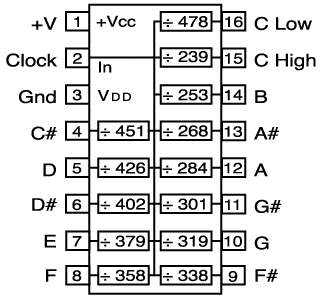
Description: 13-Note Top Octave Synthesizer IC
30% Duty Cycle Output
Order: KS-82
Cost: $39.95
Description: 13-Note Top Octave Synthesizer IC
50% Duty Cycle Output
Order: KS-83
Cost: $39.95
Description: 12-Note Top Octave Synthesizer IC
Order: KS-86
Cost: $39.95
Figure 6
Back to
Index
Description: 12-Note Top Octave Synthesizer IC Figure 7
Order: KS-87
Cost: $39.95
Back to
Index

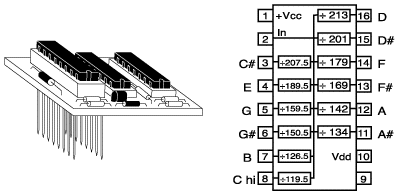
Description: 12-Note Top Octave Synthesizer
Retro
Same pinout as the MO86B except the output is one octave higher. Used
by Wurlitzer.
Order: KS-196
Cost: $69.95
Description: Replacement Dual TOS/MDD Retro For
Hammond MDD Generator Boards. Replaces All IC's, plus several other
components on the 124-265, 124-266, 124-318 and MG-2 MDD Generator
Boards.
Order: KS-MDD
Cost: $69.95
Description: Replacement Dual TOS Divider Retro For All Organs Using Dual TOS IC's. This retro replaces both the 7-note and 6-note TOS IC's.
Replaces the 7-note (S2555) and 6-note (S2556) TOS IC's.
Replaces the 7-note (M5555) and 6-note (M5556) TOS IC's.
Replaces the 7-note (S2555) and 6-note (S2556) TOS IC's.
Replaces the 7-note (S2555) and 6-note (S2556) TOS IC's.
Description: 7- 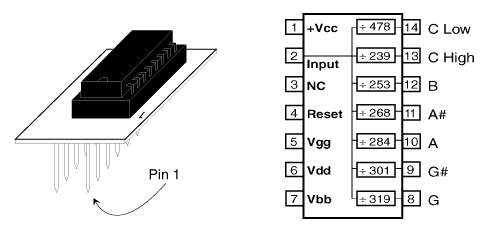 Note
Top Octave Synthesizer IC Retro
Note
Top Octave Synthesizer IC Retro
Generic
S2555
MC1183L
MM5832
(Not Compatable
with M5555)
Order: KS-813-1
Cost: $39.95
Description: 6-Note Top Octave Synthesizer IC Retro
Generic Figure 1a
S2556
MC1184L
MM5833
(Not Compatable
with M5556)
Order: KS-813-2
Cost: $39.95
Back to
Index
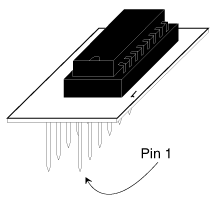
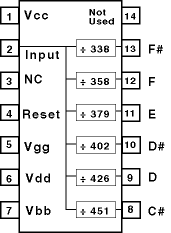

Description: Single Spider RTL Divider IC
Order: KS-4040
Cost: $4.95
Description: Dual Spider RTL Divider IC Dual
With Independent Dividers
Order: KS-6020
Cost: $8.95
Description: Dual Spider RTL Divider IC Dual
With Cascaded Dividers
Order: KS-6050
Cost: $14.95
Description: 7-Stage Divider Retro
Generic
SAJ-180
AY-1-5050
SA1005
TMS3612
Order: KS-180
Cost: $17.95
Description: 6-Stage Divider Retro
Generic
PD-455
PD-474
PD-492
MC1180L
MM5554
MM5824
Order: KS-455
Cost: $17.95
Description: 7-Stage Divider IC
Order: KS-1007
Cost: $17.95
Description: 6-Stage Divider Retro
Order: KS-3216
Cost: $24.95
Description: 6-Stage Divider Retro
Order: KS-5823
Cost: $17.95
Return to
the:
HOME PAGE |
TEXT ONLY
INDEX
MIDI
Kits: INTRO
| COUPLERS+PRESETS
| INSTALLATION
| CONTROLLER
Pre-85
Lowrey: LOWREY
ORGAN PARTS |
SERVICE
& OWNERS MANUALS
Generator
Parts: TOP
OCTAVE IC's | TOP
OCTAVE RETRO's |
DIVIDER
IC's
PC
Software: CROSS
REFERENCE MASTER |
CRM
SCREEN EXAMPLES
Support:
PARTS
ORDERS |
EMAIL TECH
SUPPORT
© 1999 Keyboard Systems 8937